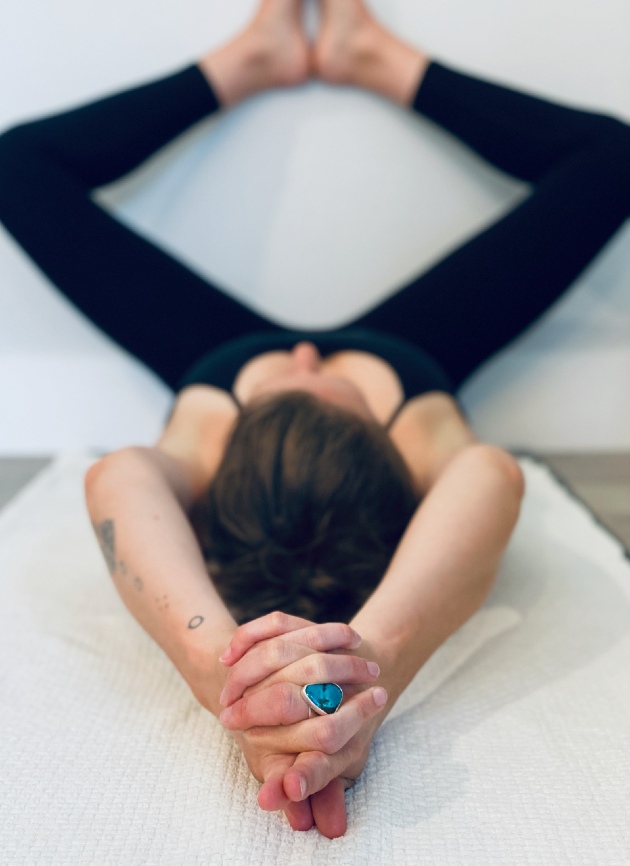How Trauma-informed Yoga Aids Sexual Assault Recovery
SexForEveryBody.com is supported by our readers. We may earn a commission if you buy through links on our site. Learn more.

When my therapist first recommended trauma-informed yoga, I was annoyed.
As a rape survivor, I hear the term “trauma-informed” a lot.
Sometimes it’s useful, like when I need to find a new therapist who knows how to engage with what I’ve experienced.
I’ve also seen the term “trauma-informed” tacked onto activities and resources unnecessarily, usually as a marketing ploy to take advantage of vulnerable people. I couldn’t imagine yoga was anything but the latter.
“Not everything needs to be trauma-informed,” I sighed reluctantly.
“Think of it as an extension of the work you’re already doing here,” my therapist prodded gently.
She’s usually right, so I decided to give it a shot.
What is trauma-informed yoga, exactly?

Trauma-informed yoga—often referred to as “trauma-sensitive yoga”—is a form of yoga as therapy developed at the Center for Trauma and Embodiment at JRI in 2002.
Oftentimes, trauma recovery only focuses on the brain and the process of healing that happens within your mind. The body stays behind and the trauma you experienced nestles within it. This can result in dissociation or involuntary, seemingly inexplicable physical reactions.
By combining therapeutic principles and modern postural yoga techniques, trauma-informed yoga, according to the center, “is an empirically validated, adjunctive clinical treatment for complex trauma or chronic, treatment-resistant PTSD.” In simpler terms, the practice is an intervention designed to empower survivors and foster recovery.
My therapist recommended that I try to find a studio near me through the Trauma Center Trauma Sensitive Yoga (TCTSY). The TCTSY website is a central resource for finding qualified facilitators trained in trauma-sensitive yoga practices.
Unfortunately, none of the facilitators in Berlin at the time were offering group classes. There were options for one-on-one individual sessions, but those can be pretty expensive. To compare, a private session would have cost me 70€ per hour, as opposed to the 50€ per month I pay for unlimited online classes.
Fortunately, one of those Berlin-based facilitators connected me to Trauma-Sensitive Yoga Nederland, which offers virtual group classes in both English and Dutch.
Related Read: How to Enjoy Sex After Trauma and Reconnect with Pleasure
How trauma-informed yoga differs from traditional practices
Despite my initial attitude towards the idea, participating in trauma-sensitive yoga classes the past six months has proven to be a great way to reconnect with my body.
Before taking a chance on this type of yoga, I felt like I was just lugging my body around day after day. I could never meaningfully label how it felt to exist in my skin. When I participated in traditional yoga classes, I felt isolated because I wasn’t able to detect particular sensations that the instructor would describe or tell us we should be experiencing.
Combining trauma-sensitive yoga with somatic experiencing therapy has allowed me to better understand what my body needs and where I hold tension or unresolved trauma. Plus it’s extremely validating to know that I’m not the only person who struggles to acknowledge my own body.
The format, however, does take some getting used to as it deviates from the yoga classes you might be used to.
In the next post, I share what to expect and how to prepare for your first trauma-informed yoga class.
Read Part Two: Preparing for Your First Trauma-informed Yoga Class
Image sources: Надя Кисільова, Awaken Live
Carolyn (she/her) is a queer software engineer and freelance journalist based in Berlin, Germany. She writes about the intersections of technology and sexuality for outlets like Future of Sex, Autostraddle, Curve Magazine, and elsewhere. You can find her most places on the Internet @carolstran.












